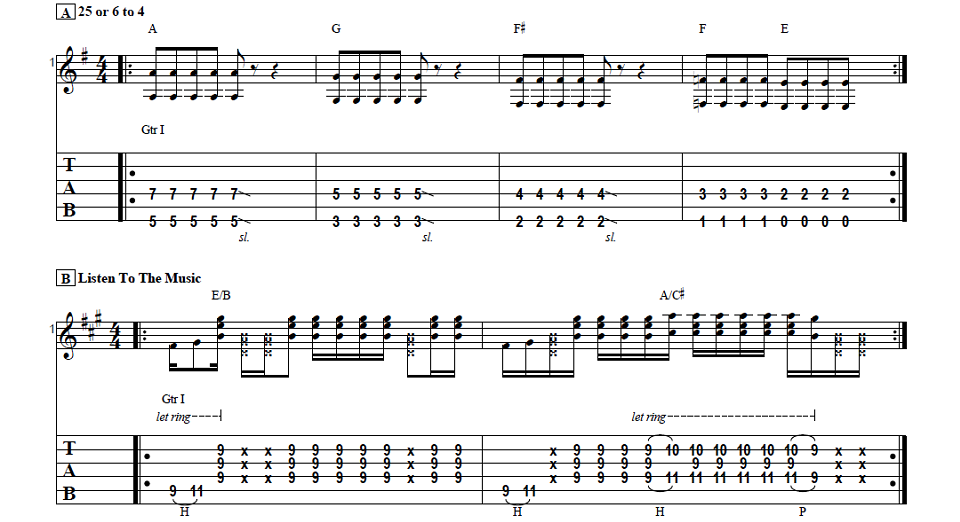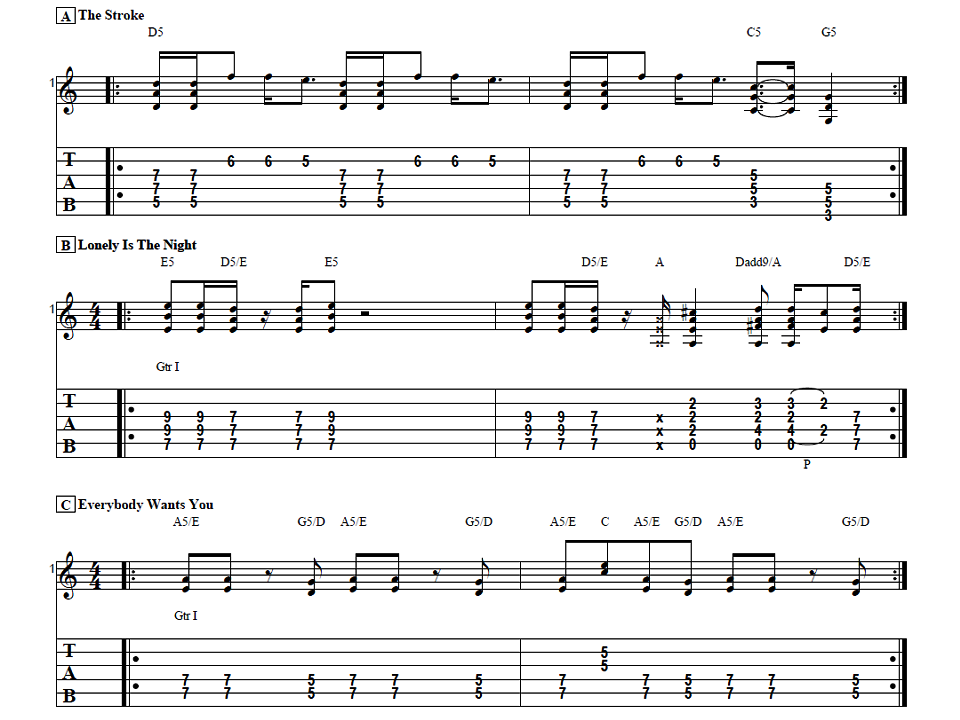Learn to play three more fun and easy riffs from the 1970s with Guitar Control instructor Darrin Goodman, aka Uncle D. Be sure to get the free tabs to go along with the step by step video instruction and you will be rockin’ these classic tunes in record time.


Introduction
Hey how’s it going everybody? This is Darrin with GuitarControl.com bringing you this video lesson and today I’ve got three more fun and easy riffs for you from the 1970s.
Right now Guitar Control is giving away this cool free chord chart and there’s a link down in the description. It’s in PDF format and has every chord that you could ever need all neatly compiled into one sheet so you can print it off you can put it where you practice or throw it in your gig bag so at a glance you can have any chord that you could be looking for in whatever situation and it’s free download, just click the link.
So be sure to click on the link in the description for the tabs and let’s get close up and take a look at these.
1970s Guitar Riff-1 – 25 or 624 – Chicago
All right so the first 1970s riff we’re going to look at is 25 or 624 by Chicago. So this one is pretty simple and it’s just made up of octaves and it’s just the same shape all the way through. So where I’m at right now on the fifth fret of the low E string with my first finger and the seventh fret of the D string with my third finger, but you want your first finger to kind of droop over so it mutes the A string; so that way when I strum I’m just getting those two notes, both A, just an octave apart from each other and then that mute in between so just fattens it up a little bit. So this is just made up of eighth notes so we’ve got one and, two and, three and, four. So we rest on the and of three and all of beat four and that’s the first measure. So when we hit that last strum on the downbeat of three we slide out of it… then we simply move down whole step so now we’re on G, do the same thing; so first fingers on the third fret of the lowest string and third finger is on the fifth fret of the D string… Now we go down a half step so now I’m on the second fret of the low E string and the fourth fret of the D string, so this is F sharp (F#)… All right so that’s our first three measures… So for that last measure we’re going to come down a half step again so we’re doing F; so I’m on the first fret of the low E string and the third fret of the D string and we’re going to do this for half of the measure so one and two and, and then starting on the downbeat of three we go to an E. So what we’re going to do is we’re going to take our first finger off and drop our second finger to the second fret of the D string that you kind of want to use the tip of your finger to kind of touch the side of the A string to mute it; so again we get the same note… and then it just starts over again…
1970s Guitar Riff-2 – Listen To The Music – The Doobie Brothers
All right so the next 1970s riff we’re going to look at is Listen To The Music by The Doobie Brothers. So this is a really fun little riff to play. It sounds really cool and it’s a great rhythmic exercise. So the first thing we’re going to do we’re going to come here to the 9th fret with your first finger and we’re gonna pick the ninth fret on the A string and we’re gonna pick that and then do a hammer-on to the 11th fret with our third finger, just like that. Then we’re going to follow that with our first chord which is E over B (E/B); so all I’m going to do is take that first finger and just barre across the ninth fret of the D, G and B strings… Then we have two muted strums and I’m just basically just letting off the pressure here so I’m just touching the strings and then when I strum them I just get that percussive sound. So if you look at the on there you know this is a 16th note and this is an eighth note and then this is a 16th note; so it’s like… Then these two are 16th notes two mutes and then… the full chord is an eighth note, then four sixteenth notes mute,two full chords and that’s our first measure. Second measure starts off the same way with that same 9 hammer to 11, but this time we start with a mute and then 4 16th notes and on the fourth one we’re going to do a hammer-on and make this an A over C sharp (A/C#). So what we’re going to do and this is going to be kind of the trickier part if you’re a beginner is that we’re going to hammer two strings at the same time. So you’re going to keep your first finger barred here at the ninth fret but you’re going to hammer down to the 10th fret on the B string with your second finger at the same time that you’re hammering to the 11th fret of the D string with your third finger… so you get the this other chord voicing. So we hammer at the beginning of the second measure, so we have the hammer mute one two three four because it’s four sixteenth notes hammer to the to the A/C# and then you’ve got 4 16th notes… and then a fifth one pull-off followed by two mutes and then the whole thing just repeats. So when you’re playing it really slow it’s really kind of kind of hard to to imagine how it’s supposed to sound once you start speeding it up just a little bit…
1970s Guitar Riff-3 – Sign Of The Gypsy Queen – April Wine
All right and then the last riff we’re going to look at is Sign Of The Gypsy Queen by April Wine. So this actually this intro part of the song has three guitar things that are happening, but um so you’ve got a rhythm and then you’ve got a melody and then a harmony to that melody. So we’re going to do is we’re going to go over the rhythm part and we’re going to go over the melody part, but we’re not going to do the harmony part because this way you can play it like with your looper, you can loop the rhythm section and play the melody over it or you know record it with your phone or just whatever play it with a friend… All right so we start off we rest on the first two beats and then starting on beat three we have this little little run so we’re starting on the third fret of the A string and I’m using my second finger three and then on the and of three we go to the second fret with your first finger the downbeat of four is the open A string and the and of four is the third fret of the low E string and then that brings us right to the downbeat of the second measure; so we have an E5… So I’m just gonna take my first finger just barre the second fret of the A and the D string and the low E string open and this is a whole note, so this gets four beats one two three four. Then on the next measure we’re going to go to a D5 so just take your first finger move it up to the fifth fret on the A string third finger picks up the seventh fret of the D string and you can also pick up the seventh fret of the G string with your fourth finger, but if that’s difficult for you if you’re a beginner that’s okay again be a full two measures. Next measure we’re going to come down and do an A5; so first fingers barring the second fret of the D and the G string, the A string is open this is also whole note one two three four. Then we go to a C5; so if we take the D5 shape we did and just move it down a whole step so now your first finger is on the third fret of the A string and your third finger’s on the fifth fret of the D string and we hit this and it’s a half note this time one two and then starting on beat three we do the same little run we did at the beginning and then it just repeats… All right so that’s for the guitar one for the rhythm part now we’re going to look at what guitar two is doing for a little melody over it. So guitar two rests the entire first measure and then on the second measure where on the downbeat of one the rhythm is doing that E5 is a is a whole note we start we beat one and then on beat two we’re going to go to the 15th fret on the B string. So this all these notes we’re going to be doing here are all just out of the E minor pentatonic scale pattern one. So we go to the 15th fret, I’m going to use my third finger, I’m going to put my second finger on the 14th fret also on the B string and my first finger on the 12th fret so that way I have leverage to bend. So we’re going to do this as a half note so 1 2 3 and then we release the bend and on the downbeat of four we hit the 15th fret and the and before the 12th fret so that’s another good reason to have your first finger back here. Then on the on the second measure well it’s actually the third measure but the second measure of the repeat we bend this up at the 15th fret a whole step, again this time it’s just a quarter note, one, then we release it, two three four, because it’s a dotted half note so those two measures. Then on the fourth measure but the third measure of the repeat it’s the same as the first measure again and then on the last measure we do 15 pull to 12 on the B string, but at 16th notes to the 14th fret of the G string to the 12th fret of the G string; so it just descends the scale basically… So you go to the 12 little vibrato on it then to the 14th fret and then it would just repeat… Now if you’re just playing it just by yourself one thing you could do is you could do the little run and then just hit your open low E string for beat one and then start playing the little melody… So you can see that this can kind of help you to keep where you are you know your place in the song and then also add some of the other notes that are missing to kind of just keep the whole thing together, but I would just record the rhythm part and play that little melody over the top of it.
Conclusion
All right so there you have it three fun, not too terribly difficult riffs to play from the 1970s. So if you like this lesson be sure to give me a thumbs up and leave a comment down below if you have any questions about this or other guitar related topics. If you’ve not already done so please subscribe to the channel and hit that notification bell so you don’t miss any of the content that we upload throughout the week. Well that is all I have for you today. Thanks for watching 3 fun and easy riffs from the 1970s Vol-2 and have a great day.



